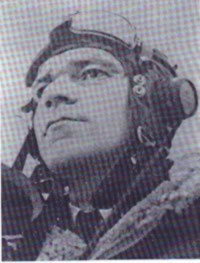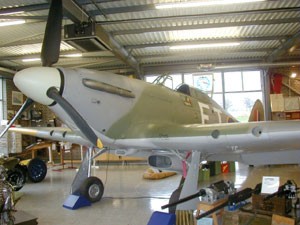
Daniel Le Roy du Vivier was born in
Amersfoort (Holland) on January 13 1915.
After obtaining a degree in Commercial Sciences at the Catholic
University of Leuven.µ, Le Roy du Vivier entered active service as private
in the 1st regiment des Guides on July 31 1935. When his military service
came to an end he re-enlisted as a student-pilot on April 1st 1937.
With his training finished, he was granted his pilot license on March 15 1938 and
was sent to the 1st regiment d’Aeronautique 11th group 4th squadron on
September 14 1938.
Promoted Pilot-Sergeant on September 26 1938 he studied at the Military
Arms school in Evere where he became a second lieutenant.
On May 10 1940, during the German attack , he was stationed in Nivelles
with the rank of Adjudant. Volunteering for a high risk mission he
patrolled with a Fairey Firefly single-seat in the area of Antwerp-Leuven-Brussels
accompanied by Major Jacques Lamarche and Lieutenant Yves du Monceau de
Bergendal.
He was shot down above Keerbergen by
'friendly fire'.
Because of the German push forward he was forced to go to
France with his unit on May 15 1940. After a period of inactivity the
pilots received the order to surrender on June 19 1940. Rather than
surrender,
Le Roy du Vivier and several other pilots (de Henricourt de Grune, Van den Hove
d'Ertsenryck, Wilmet, Willy Van Lierde, Vichy Ortmans, Georges Doutrepont,
Francis de Spiriet, Roger Malengreau) decided escape. They managed to
get to Port-Vendres where they boarded the SS Apapa on June 23 1940. By
June 27 1940 they had arrived at Gibraltar and continued on to Liverpool.
Upon his arrival he was instantly sent to the RAF depot at
Gloucester ,where he spent about 12 days at the 7th Operational Training
Unit where he was initiated into flying the fighters in service at the
time. On August 4, he transferred to the 43rd fighter
squadron, a unit that like many others, was in the thick of the Battle of
Britain.
On August 8th the Staff of the RAF added this message to the daily orders.
“The Battle of Britain has began , members of the RAF be aware that the
destiny of generations to come is in your hands”.
On the same day, 300
German aircraft dispersed in multiple squadrons cross the Channel
and attacked convoys, boats, transportation and communications
facilities.
On august 16 he downed his first aircraft , a Junkers 87.
During the afternoon of September 2 1940 the Germans attacked the bases of
the RAF which resulted in heavy aerial fighting.
During a melee above Sidcup, a small town near to London, Le Roy du Vivier
who was
in pursuit on a German fighter found himself under fire at 3000 feet
altitude and was shot down in flames. He was able to bail out and landed in the garden of a young girls school!
He was immediately
surrounded by intrigued students armed with brooms, forks and shovels he
was asked if he was British or not… Having difficulties talking in the
language of Shakespeare he decided to play dead being afraid that his
heavy Brussels accent would make him look like a German. He stayed like
this until the arrival of a police constable who could verify his identity and
get him to hospital.
From September 2 to October 22 1940 Daniel Le Roy du Vivier was treated at
the Casualty Clearing Station of Tenderen.; He then joined the 43 fighter
squadron, unit where he remained for 27 months, first as a Pilot
Officer and later as a Flight Commander and after 18 months, as a Squadron
Leader, making him the first foreigner to take command of a RAF squadron.

BN 230 was the Hurricane
Squadron Leader D.A.R.G. 'Danny' Le Roy Du Vivier DFC. BN 230 was
the first RAF fighter over Dieppe on 19th August 1942, leading the
Tangmere Wing in 'Operation Jubilee'
During the month of may 1941 he got his second victory ( a Junkers 88)
and downed 3 others in collaboration with his comrades. He was promoted to the rank of Flight
Commander.
On January 3 1942, a note from the Air Ministry awarded Le Roy du Vivier
with the D.F.C. with following citation :
“Has proven to have excellent
qualities as a commanding flight-officer, succeeding in to maintain a high
level of offensive value to his pilots during daytime and nightly
operations he has undertaken. Has destroyed 4 enemy aircraft to this day.”
He was also awarded the Croix de Guerre with bronze palms. Le Roy du
Vivier was accorded the right to wear an additional palm with 3 lions by
the Belgian Minister Of National Defence.
Le Roy du Vivier participated brilliantly in the operation 'Dieppe'
in August 1942 leading his squadron. He undertook 4 attacks on heavily
defended enemy positions coming back time after time with a damaged
aircraft. His heroism is once more rewarded by his RAF superiors who
awarded him a “Bar” on the ribbon of his DFC.
On September 22 1942 Le Roy du Vivier had to be transferred by stretcher
after a mission. He was suffering from heavy fatigue brought
on by the day to day stress of fighter operation.
In April 1943 he was attached to the Middle East Command Headquarters. Le
Roy du Vivier took command of the 239 Fighter Bomber Wing Tunis-Sicily
composed of the 1 South African Sqn , the 3 and 450 Australian Sqn’s and
the 112 and 260 British Sqn’s. He was appointed as Superior Officer
responsible for the operations at the 324 Fighter Wing composed of the 43
, 72 , 93 , 111 and 601 Sqn’s.
After the Italian campaign Le Roy du Vivier returned to the RAF on July 8
1944 where he joined the 536 Operational Training Unit and on
September 3 he was transferred to the General Inspectorate of the Belgian Air Force.
Days after the capitulation of Germany he found himself at Fasberg with 2
Belgian Fighter squadrons. When they finally returned home to Bauvechain
airfield, Wing Commander Le Roy du Vivier, (who had seriously
injured his right leg during the combat in Sicily) asked to be relieved of
duty and joined the reserve.
In civilian life he became the director of the Aviation department of the Belgian Shell
Company.
Le Roy du Vivier found that he missed the military life however.
When a first auxiliary Squadron was created in January 1950, in order to
train reserve pilots during the weekends, Lieutenant-Colonel Le Roy du
Vivier jumped at the chance to take command. At Coxyde he organised a training camp
where 15
fighter pilots could hone their aerial combat skills.
Daniel le Roy du Vivier was promoted to Reserve-Colonel on December 26
1955 and on that same year he left Belgium and became the Public Relations
director of SABENA in the United States. He left the reserves on April 1 1970
when he reached the age limit.
Le Roy du Vivier died in a car accident on September 2 1981…….
